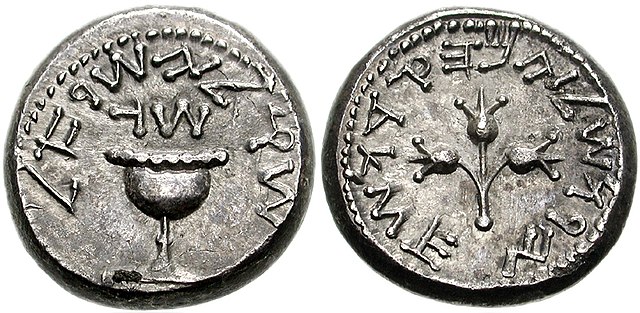Top Qs
Timeline
Chat
Perspective
First Jewish Revolt coinage
Coins minted by the Jews of Judaea during the First Jewish–Roman War From Wikipedia, the free encyclopedia
Remove ads
First Jewish Revolt coinage refers to the series of coins minted by Jewish rebels during the First Jewish–Roman War (66–73 CE). These coins adopted distinctly Jewish symbols, such as pomegranates, lulavs (palm branches), and Hebrew inscriptions in the paleo-Hebrew script proclaiming messages like "For the Freedom of Zion" and "Jerusalem the Holy." The coinage, which included silver shekels and bronze denominations, marked a revival of Jewish political independence, with years dated according to the revolt. Beyond their economic role, the coins served as a symbol of resistance against Roman rule and an assertion of Jewish sovereignty and economic freedom. It is now accepted that they were minted in Jerusalem.[2][3]




Remove ads
History
Summarize
Perspective
In the Revolt's first year (66–67 CE), the Jews minted only silver coins, which were struck from the Temple's store of silver.[4] This was the first instance of silver coinage in Jewish history.[5] The newly minted silver coins included shekels, half-shekels, and quarter-shekels, each being labelled with the year of minting and their denomination.[4] and depict a chalice on the obverse with the year of the revolt above, surrounded by the ancient Hebrew inscription "Shekel of Israel". Three budding pomegranates are featured on the reverse, with the inscription "Jerusalem the Holy".[6]
During the second (67–68 CE) and third (68–69 CE) years of the Revolt bronze prutah coins were issued, depicting an amphora, and with the date and the Hebrew inscription (חרות ציוןhola Herut Zion)"The Freedom of Zion".
In the fourth year of the revolt (69–70 CE) three large sizes of bronze coins were minted, possibly because the supplies of Temple silver were diminishing. It is believed by numismatists that these coins were fractions of a shekel. The smaller of these coins also has the depiction of a chalice, together with symbols of the Jewish harvest festival of Sukkot, a lulav and etrog, and the date and inscription "For the Redemption of Zion". This coin is usually called an 'eighth', probably being an eighth of a shekel. There is broad scholarly agreement that coins issued by the Judean government during the Revolt use an archaic Hebrew script and Jewish symbols including pomegranate buds, lulavs, etrogs, and phrases including "Shekel of Israel," and "The Freedom of Zion" (חרות ציון Herut Zion,) as political statements intended to rally support for independence.[7]
The medium size coin has the same inscription, with the denomination "reva" (quarter) inscribed. An etrog is depicted on the obverse, and two lulav are on the reverse. The larger of the three bronze coins are inscribed "chatzi" (half). On the obverse a lulav and etrog are again depicted, with a palm tree and baskets on the reverse.[6] These coins are sometimes referred to as 'Masada coins'.
Robert Deutsch assumed that the coins would not have been easily readable by the general population,[8][9] as by this period, the Paleo-Hebrew script had become obsolete,[10] with the square Jewish script becoming more dominant. According to Hannah Cotton, the use of Hebrew represented Jewish nationalism and served to promote the ideology of the independent Jewish state.[10] Jonathan Price notes that "the palaeo-Hebrew letters strengthened the nationalistic declaration."[8]
Remove ads
Research
The coins, which have been known since medieval times, were formerly described as having Samaritan inscriptions.[11][12][13] It was not until the mid-20th century that they were correctly attributed to the First Jewish Revolt.[14]
Hoards
Five hoards of bronze coins from the revolt were documented as of 2017.[15][16] One of these was discovered at the desert fortress of Herodium in 1968/1969, containing 19 coins: 3 from the 2nd year and 16 from the 4th.[15] A second hoard was discovered on the street near Robinson's Arch in Jerusalem, with over 100 coins, most of them from the 2nd year, but also some from the 3rd and 4th years, as well as one coin of an unnamed Roman governor.[15]
In 2014, another hoard was uncovered at Horbat Mazruq, the site of an ancient Jewish village near Kiryat Ye'arim. It included 114 uncirculated coins, all in excellent condition and dating from the 4th year of the revolt. It is believed that the coins were hidden by someone on a reconnaissance mission, sent to territory already captured by the Romans.[15]
Interpretation
According to historian David Goodblatt, the use of the term "Freedom to Zion" on circulating coinage aimed to convey the rebels' goals to the masses, mobilizing them to fight for Zion. This can be compared to the ideals expressed in modern Zionism, particularly in the anthem "Hatikvah," suggesting that the rebels' ideology may be characterized as an early form of Zionism, "Zion nationalism."[17]
According to James S. McLaren, the names inscribed on the coins may represent three levels of identity: "Zion," referring to the Temple Mount; "Jerusalem," signifying its location; and "Israel," denoting the new Jewish state with Jerusalem as its capital.[18]
Remove ads
See also
- Historical currencies in Judaea
- Judaean and Judaea-related coinage
- List of historical currencies
Remove ads
References
Bibliography
External links
Wikiwand - on
Seamless Wikipedia browsing. On steroids.
Remove ads
